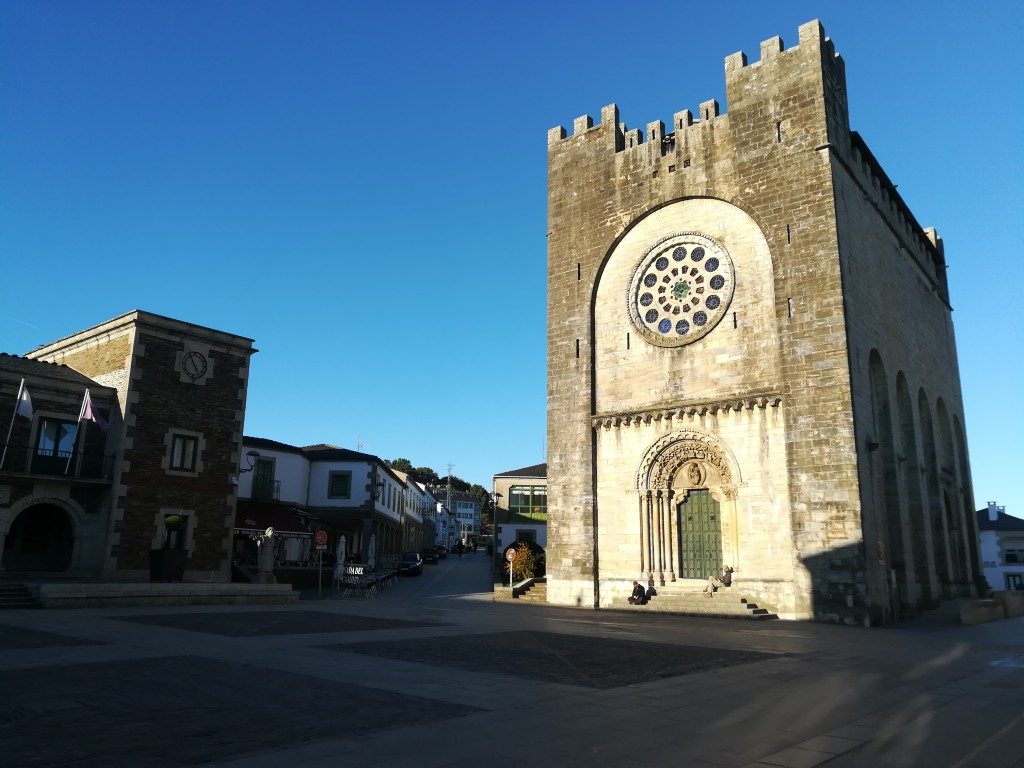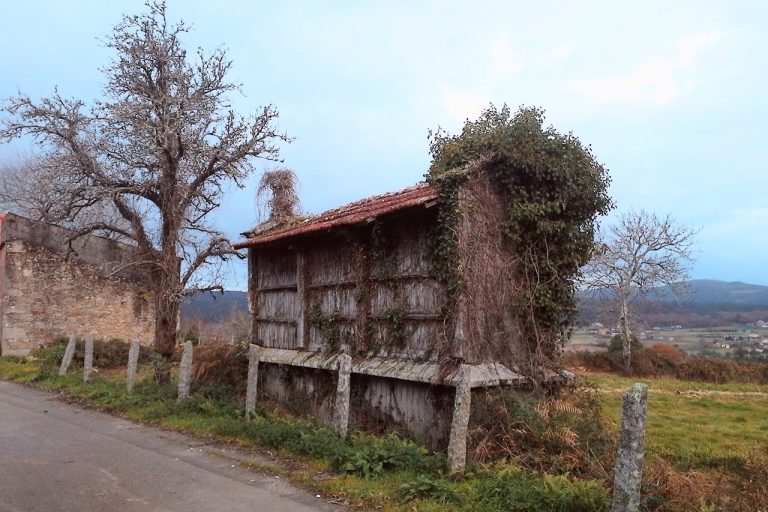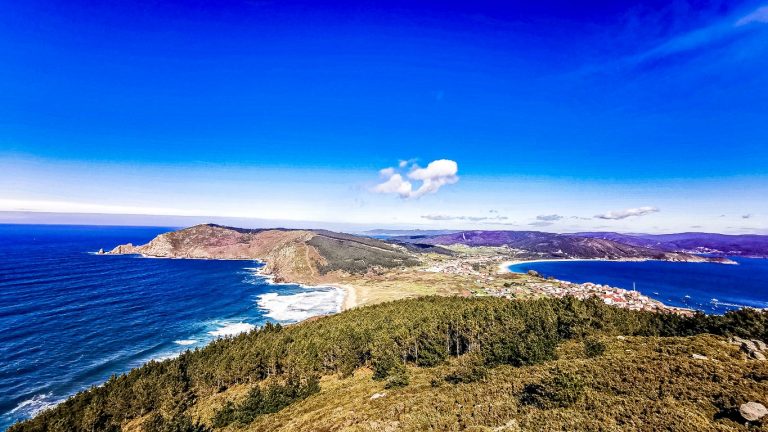
A New Day on the Camino – Introduction & Atmosphere
After a night within the quiet monastery walls of Samos, accompanied by the murmur of the Río Oribio, you set out today on one of the longest stages of the entire St. James Way (Camino Francés): almost 37 kilometers lie ahead of you. But don’t worry – the elevation gain is gentler than in previous days, and you are now moving into the green, gentle heart of Galicia.
The path leads you through Sarria, that place which for many pilgrims marks the true starting point, since from here you cover the obligatory 100 kilometers to Santiago. For you, however, Sarria is only a milestone on a long stage that will finally take you to the Miño River and into the historic pilgrim town of Portomarín.
Today you will experience the essence of the Galician Camino: rural villages, ancient churches, small wooden bridges over clear streams, oak and chestnut forests, spontaneous roadside crosses and altars, and everywhere the small signs of the pilgrim community – stone cairns, scallop shells, colorful ribbons. It is a day that stays in memory, both for its length and for its variety.
Route & Elevation Profile
- Distance: 37.2 km
- Elevation: approx. +950 m / –1,050 m
- Difficulty: high (mainly because of the length)
- Character: long but gentle ascents and descents, mostly forest and meadow paths, often earthy and muddy in rain












Many pilgrims split this stage:
- Short option: Samos → Sarria (approx. 13 km)
- Medium option: Sarria → Portomarín (approx. 24 km)
Those who walk both sections at once experience a full Camino day in its entirety – from monastic silence to the great Miño River.
Step-by-Step Description of the Route
From Samos to Sarria
The first kilometers take you along the LU-633 through small hamlets. You pass Teiguín with its riverside recreation area and reach Pascais, with its church of Santa Uxía, after a short ascent. Soon the path leads through woods and fields to Gorolfe and across small streams to Calvor (approx. 5 km).
Here rises the Iglesia de San Esteban, founded in the 8th century on top of a Celtic castro. A place where Roman times, the early Middle Ages, and pilgrimage tradition overlap.
Through Aguiada and San Mamede do Camiño you finally reach Sarria (approx. 13 km). For you it is a waystation – but for many pilgrims, the journey begins here. Sarria is considered “Kilometer Zero” for the last 100 km to Santiago.
Worth seeing are the church of San Salvador, the convent of La Magdalena, and the picturesque Rúa Maior with its cafés and pilgrim shops.
From Sarria to Barbadelo
Beyond the old town a descent takes you to the medieval Áspero bridge over the Río Celeiro. From here you walk on field tracks and narrow footbridges into the woods. Soon you arrive at the small settlement of Barbadelo (approx. 18 km), with its Romanesque church of Santiago (12th c.), a national monument and one of the finest examples of Galician architecture.
Via Molino de Marzán and Morgade
The route continues through meadows, woodland, and quiet villages. You pass Molino de Marzán (21 km), an old mill that now offers pilgrims lodging, and soon reach Morgade (approx. 26 km). Here stands the little Chapel of the Holy Trinity, where pilgrims leave handwritten notes with wishes and prayers of thanksgiving.
Ferreiros – the 100-km Symbol
Shortly afterwards you reach Ferreiros (27 km), where many pilgrims celebrate, for here begins the last 100-kilometer stretch to Santiago. Numerous stone markers, crosses, and small roadside altars line this section – quiet witnesses to longing, gratitude, and hope.
From A Pena to Mercadoiro
The path continues through the small places of A Pena, Couto, and Rozas. Soon you arrive in the hamlet of Mercadoiro (31 km), located on an old Roman road. Here you feel the character of an ancient transit point.
Vilachá and the Descent to Portomarín
Through Moutrás and Parrocha you reach Vilachá (34 km). Once the site of the Monasterio de Loio, cradle of the Order of Santiago, its ruins and the small church of Santa María de Loio recall this origin.
The path now descends steeply into the valley of the Miño. Finally you cross the modern bridge that leads you to Portomarín (37.2 km).
Destination: Portomarín
Portomarín, once a Roman settlement, later an important medieval trade and pilgrim town, was almost completely relocated in the 1960s: when the Belesar reservoir was built, the old town disappeared beneath the water, and its most important buildings were dismantled stone by stone and rebuilt higher up.
Sights include:
- Iglesia San Nicolás (13th c.), a fortress church of the Knights Hospitaller, massive like a castle.
- Iglesia San Pedro (1182) with Romanesque portal.
- Casa del Conde (16th c.) and Palacio de Berbetoros (17th c.).
- The white façades along the Miño – symbols of a new beginning after resettlement.
Highlights & Landmarks
| Place | Distance from Samos | Special Feature |
| Calvor | 5 km | Church of San Esteban (8th c.) on Celtic castro |
| Sarria | 13 km | Pilgrim center, start point of last 100 km |
| Barbadelo | 18 km | Romanesque church of Santiago (12th c.) |
| Morgade | 26 km | Trinity Chapel with pilgrim messages |
| Ferreiros | 27 km | “100 km to Santiago” milestone |
| Mercadoiro | 31 km | Roman traces, ancient trading post |
| Vilachá | 34 km | Ruins of Monasterio de Loio, origin of Order of Santiago |
| Portomarín | 37.2 km | Fortress church San Nicolás, town rebuilt after flooding |
Packing & Provisions Tips
- Long distance: start very early (in summer no later than 6:30 a.m.).
- Walking poles for the sometimes slippery ascents and descents.
- Use the stopovers: Sarria, Barbadelo, Morgade, and Ferreiros have bars & albergues.
- Carry plenty of water – between Morgade and Portomarín there are few springs.
Food & Accommodation
- Sarria: huge choice of hostels, guesthouses, hotels.
- Barbadelo & Morgade: charming rural albergues.
- Ferreiros & Mercadoiro: classic pilgrim stops.
- Portomarín: wide range from modern albergues to cozy hostales. Particularly impressive: an evening walk across the Miño at sunset.
Culinary Delights
Galicia now welcomes you in full force:
- Empanada de anguila – local eel specialty.
- Tarta de Portomarín, similar to Tarta de Santiago but with its own character.
- Ternera gallega – tender beef of the region.
- Porco celta – ancient pig breed rediscovered.
- Orujo – Galicia’s strong pomace brandy.
What Makes Today Special
This stage combines monastic stillness, the pilgrim starting point, and knightly myth. In Samos you step out of the venerable halls of the Benedictine monastery into a new day. The mighty walls, which have sheltered pilgrims for centuries, leave you with one last breath of silence and composure before you set out again.
In Sarria you encounter a different picture: crowds of new pilgrims, full of anticipation and tension, setting out here to walk the last 100 kilometers to Santiago. It is a lively, sometimes almost overwhelming contrast to the quiet of Samos – and at the same time a reminder that every Camino has many faces.
Beyond Ferreiros you cross the magical marker of 100 kilometers to Santiago. The little milestone by the wayside is unassuming, but for many pilgrims it carries deeper meaning: it stands for the goal now within reach, and for the certainty that every step truly brings you closer.
In Vilachá you encounter the origins of the Order of Santiago. Here, in the ruins of the Monastery of Loio, that order began, once protecting pilgrims and later becoming one of the most influential religious communities in Spain. History and legend intertwine at this place, lying quietly in the greenery, yet carrying the echo of centuries past.
And finally you reach Portomarín, the town that was built twice. When the Miño reservoir threatened to swallow the old town in the 1960s, its most important buildings were dismantled stone by stone and rebuilt above the water. Portomarín thus tells of farewells and new beginnings – a symbol of the Camino itself, where you leave the old behind and embrace the new.
Reflection at the End of the Stage
When you look back across the Miño Bridge in Portomarín in the evening, you see the shadows of the old town in the water and above you the lights of the new. Just so, the Camino carries forward the old within you and offers you the new. Today you have walked farther than many ever do – and are closer to Santiago than ever before.
Final Reflection
This long stage unites the spiritual depth of an ancient monastery, the joy of new beginnings in Sarria, the quiet power of the 100-kilometer marker, and the story of a place that rose twice. It is an invitation to reflect on transitions and new constructions in your own life: What do I leave behind, what do I build anew? Like Portomarín, which faced the water and yet preserved itself, we pilgrims too can make every ending into a beginning.
📊 Tabular Overview
| Stage | Start | Destination | Distance | Elevation | Difficulty | Variant |
| 29 | Samos | Portomarín | 37.2 km | +650 m / –850 m | medium–high | Sarria–direct (22 km) |
Total distance: approx. 37 km – Walking time: 9 hours – Difficulty: high
🌌 Camino of the Stars
Samos → Calvor → Sarria → Barbadelo → Molino de Marzán → Morgade → Ferreiros → A Pena → Mercadoiro → Vilachá → Portomarín
Get ready for a stage that challenges you and richly rewards you. Whether you are beginning anew in Sarria or have already walked many kilometers – this way offers spirituality, history, and the certainty that you are truly close to Santiago. Embrace the diversity of this stage and feel how the Camino transforms you.


